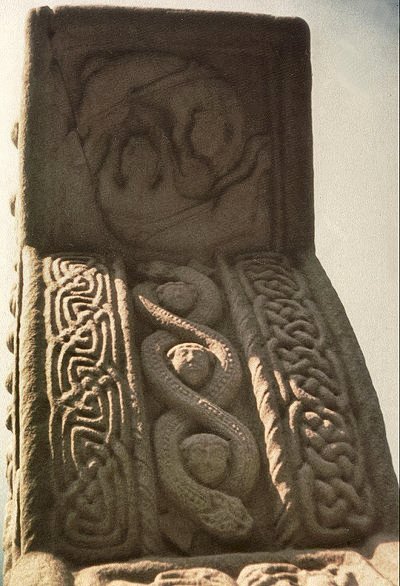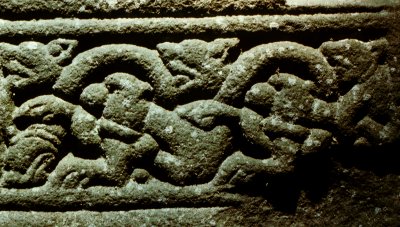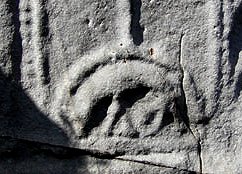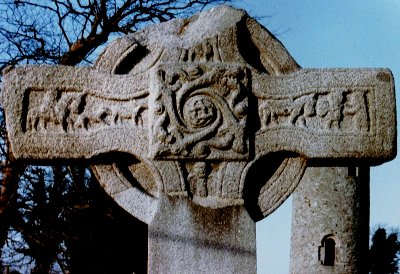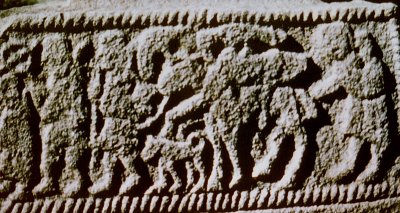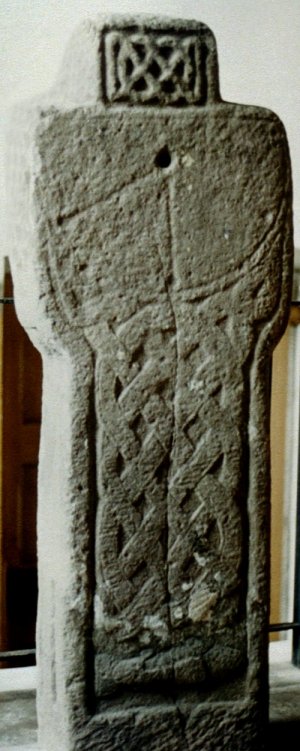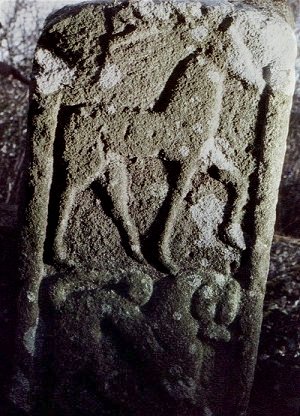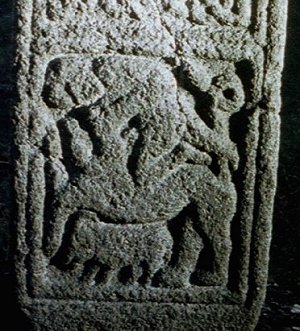|

map of crosses
field
guide
irish prehistoric tombs:
court-tombs
portal-tombs
passage-tombs
wedge-tombs
stone
circles
petroglyphs
(rock art)
standing-stones
stone
forts, crannógs & souterrains
ogam-stones &
cross-pillars
cross-pillars
& cross-slabs
enigmas
of the irish crosses
part two
sweathouses
ireland
& the phallic continuum
satan
in the groin
the
earth-mother's
lamentation
east of brittany:
megaliths of western and southern france
génie
française
sitemap

Search
>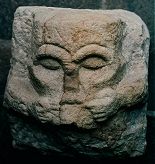
These pages are dedicated to the
memory of my mother, Martha Weir, with whom I travelled and photographed
so much.

|

The Baptism of Jesus, 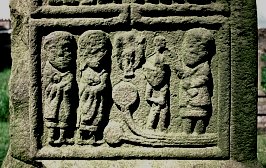 Broken Cross, Kells
Broken Cross, Kells
ENIGMAS OF THE IRISH CROSSES
part
two
|
Muiredeach's
Cross at Monaster-boice has more surprises.
There is a strip of heads entwined with very Continental
lion- or cat-headed snakes (right), suggesting some
strangulation of the soul by evil. Above them, right under
the South arm of the cross, are two Pictish-looking lying
or fighting lions.
Snakes (never part of the Irish fauna) also form a knot,
together with spheres, on one face. 
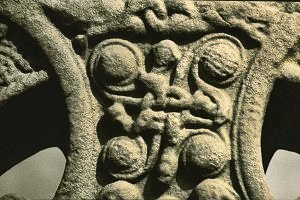
Interlace
has always been a very popular design throughout the world
but especially in Romanesque Europe. "Green Men"
often sprout or spew interlaces of foliage, and foliage-interlace
often symbolises the snares of base or animal desires.
There
are plenty of examples on Pictish stones, and on Irish crosses,
as at Tihilly (right), where the interlace is of
beasts.
|
|
Other
interlacing beasts can be seen, affronted, at Clonmacnois
(below) and, later, at Dysart O'Dea. 
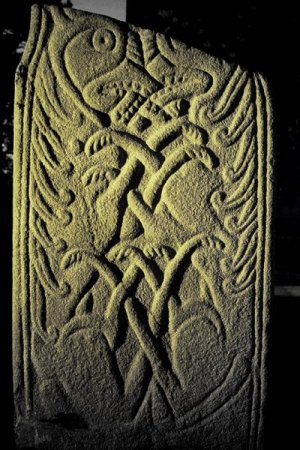
They
are probably as much decorative as symbolic.
Also
at Clonmacnois the human interlace on the North cross
adopts a rare form in a figure which paganists have identified
as a squatting (possibly Satanic) Cernunnos, the Celtic
horned god. 
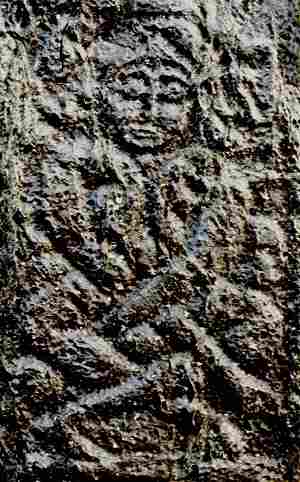
|
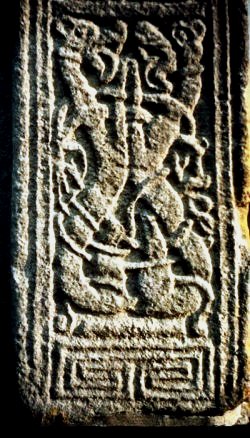
And
what are we to make of the wonderfully-carved figure below,
on the "Cross of the Scriptures" at Clonmacnois,
featuring a shepherd playing pan-pipes, with cats at his
feet and a cat licking itself ? Is it David the shepherd
with lions prefiguring his ascent from bully-boy
war-lord to monarch ?
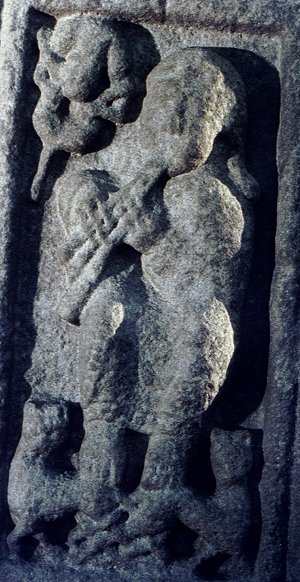
|
On
the East face of the South Cross at Monasterboice is a
perfectly intelligible scene of the Last Judgment, with
St Michael the Archangel weighing the souls below Christ
in Majesty (bearing a symbol of Osiris as well as a cross!),
on whose right hand the Saved rejoice with a harpist,
while on his left the Damned are kicked into Hell by a
devil. This is pure Romanesque and scenes like it occur
all over Europe.
|
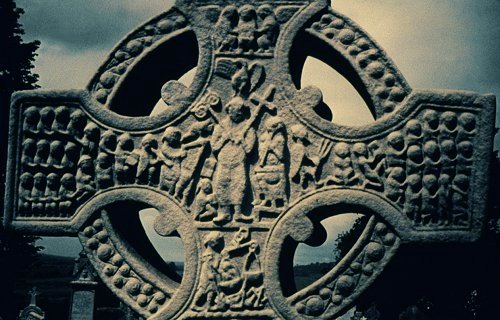
But one figure is uninterpretable: the splay-legged, possibly
female figure between Satan and his minion, which has
in the past been thought rather far-fetchedly to be a
sheela-na-gig. Does it represent the sins of the
flesh for which the damned are going to suffer eternally
?
|
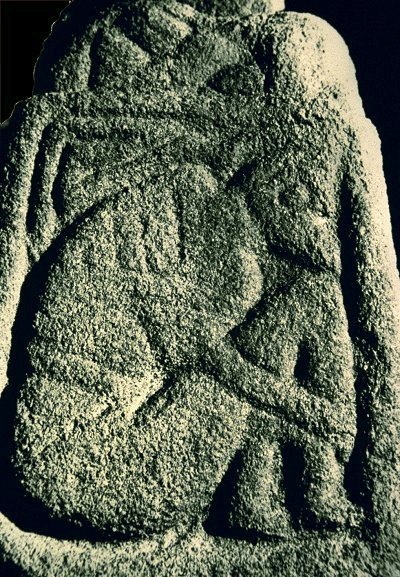
And
what meaning has the frog - or bulldog - at Drumcliffe
? 
|
 Even more enigmatic is a sad figure on the North cross at
Castledermot which is reminiscent of the bound Loki of Scandinavian
myth or the Bound Satan of the Beatus manuscripts. His profile
recalls "The Bishop's Stone" at Killadeas in Fermanagh.
Does he represent Satan conquered or the sins of the world
? Why is he holding his legs ?
Even more enigmatic is a sad figure on the North cross at
Castledermot which is reminiscent of the bound Loki of Scandinavian
myth or the Bound Satan of the Beatus manuscripts. His profile
recalls "The Bishop's Stone" at Killadeas in Fermanagh.
Does he represent Satan conquered or the sins of the world
? Why is he holding his legs ?
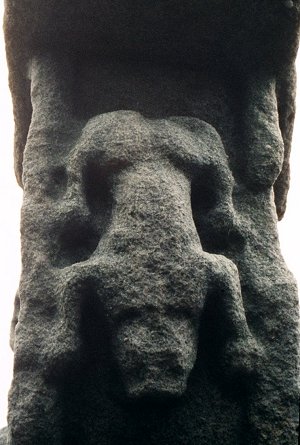
|
|
|
Or
this monster or wolf or boar at Donaghmore (Tyrone) ? It
closely resembles a boar (or bear with bristles on its back)
with a long tail curling between its legs on a Pictish slab
at Gask in Perthshire.
|
If some enigmas are related to curious continental carvings or
to Norse myth, others (like the "Cernunnos" figure)
seem to be purely Irish or Pictish. For example: the strange processions
that appear on cross-bases and, in one striking example, across
the East face of one cross.
|
|
 Here
at Dromiskin (with the broken round tower or Irish campanile
behind) is a line of animals and men: a horseman, a dog,
a ?goat, a donkey carrying a headless corpse, a man carrying
the head, and a figure with arms outstretched waiting
to receive the head. This may seem to be a pagan ceremony
- but is thought to represent the transportation of Goliath's
body and severed head to King Saul. In any case, it recalls
pre-Christian Celtic cults of the severed head .
Here
at Dromiskin (with the broken round tower or Irish campanile
behind) is a line of animals and men: a horseman, a dog,
a ?goat, a donkey carrying a headless corpse, a man carrying
the head, and a figure with arms outstretched waiting
to receive the head. This may seem to be a pagan ceremony
- but is thought to represent the transportation of Goliath's
body and severed head to King Saul. In any case, it recalls
pre-Christian Celtic cults of the severed head .
The
same theme occurs on the North Cross at Ahenny, though
rather more crowded on the cross-base. Crows or ravens
peck at the corpse. The dog with a curly tail (like that
of mine) is particularly clear.
|
|
Other
processions are less surprising, but nonetheless puzzling
- such as this apparent hunting procession on the base of
the Tower Cross at Kells. 
In mediæval Christianity the hunted stag represented
Christ...
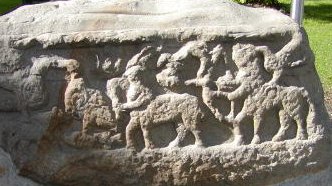
The Kells crosses have strong affinities
with Pictish stones.
Horses
feature also on the cross-base at Denn Glebe. 
At
Ahenny, on the opposite side to the headless-corpse procession,
there is what seems to be almost a zoo scene (below right)
which might be the herding of creatures towards Noah's Ark.
But is more likely to be Adam (beneath the Tree of Wisdom)
amongst the Beasts of the Garden of Eden, a scene which
occurs in Romanesque contexts elsewhere, notably the cathedral
tapestry at Girona in Catalonia.
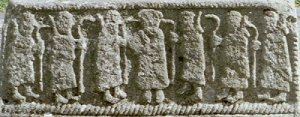
On
a third side of the Ahenny North Cross is what Peter Harbison
interprets as Christ's mission to the Apostles - or an abbot
with monks bearing croziers - which are not to be confused
with Cain's cudgel, graphically shown (below) on
the cross-shaft at Connor. The enigma here is who the third
person may be.
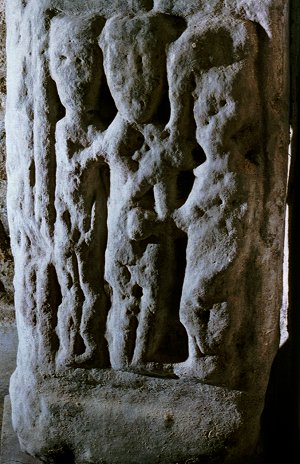
|
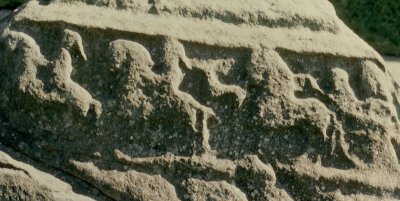
 ...but
on the Market Cross at Kells (left) is another
procession which includes the centaur-sagittarius with
a bird on its back. The centaur symbolised either man
above the animal or man brought low by the beastly, but
as sagittarius it represented Christ. The bird might represent
the Holy Ghost... ...but
on the Market Cross at Kells (left) is another
procession which includes the centaur-sagittarius with
a bird on its back. The centaur symbolised either man
above the animal or man brought low by the beastly, but
as sagittarius it represented Christ. The bird might represent
the Holy Ghost...
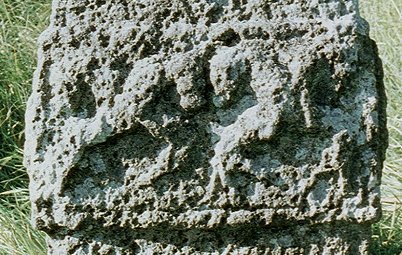
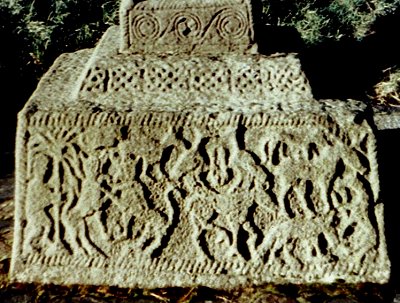
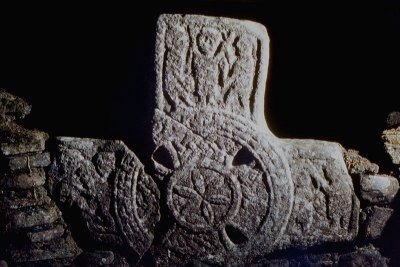

The
weapons shown on the top of the Ardane cross, however,
might be the staves used for the Arrest of Christ, a common
theme. This panel has also been interpreted as The Second
Mocking of Christ, and even the Ascension. The embracing
figures on the left are thought to be Judas kissing Jesus,
while the scene on the right may be the First Mocking
of Christ.
|
|
At
Clogher there is a cross-shaped sundial (the back of which
has a human figure) bearing familiar types of interlace
- and a salmon. The salmon is one of the most important
of magical beasts in Irish mythology: it symbolised knowledge
and wisdom and was associated with the river Boyne. It also
occurs on Pictish stones.
The
Clogher sundial may be saying that both time and Christianity
are wisdom.
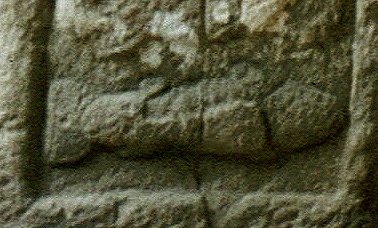
|
|
|
|
 In
Ireland and Pictland, as also in Romanesque art in general
(especially in far-flung and rustic locations) the iconology
(meaning) seems unnecessarily obscure to us. At Roscrea,
for example, the stag might represent Christ as sacrificed
ruler of Creation, while the eagle-headed lion represents
the triumph of Christianity.
In
Ireland and Pictland, as also in Romanesque art in general
(especially in far-flung and rustic locations) the iconology
(meaning) seems unnecessarily obscure to us. At Roscrea,
for example, the stag might represent Christ as sacrificed
ruler of Creation, while the eagle-headed lion represents
the triumph of Christianity. 
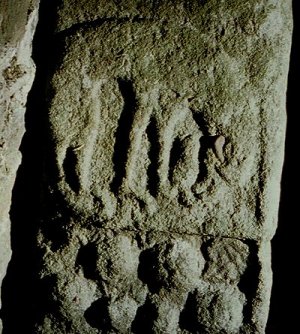
 This apparently-puzzling scene on the cross at Old Kilcullen
recalls the fragments at Moone (previous page), but is not
static - it seems to represent a scene. It is David wrestling
the lion - underneath which is a sheep!
This apparently-puzzling scene on the cross at Old Kilcullen
recalls the fragments at Moone (previous page), but is not
static - it seems to represent a scene. It is David wrestling
the lion - underneath which is a sheep!
|
|
As
enigmatic as the motif with flanking beasts is that of wrestling
or embracing figures. These might represent Jacob and the
Angel or perhaps David embracing Absalom...either is possible.
At Durrow (right) is either the Flight into Egypt
(no room for the donkey) or Elizabeth carrying the infant
John the Baptist with Zacharias indicating his dumbness,
and below it, two wrestling or embracing figures which Peter
Harbison suggests may be John the Baptist embracing Jesus
in the Desert.
On
the base of the South Cross at Castledermot (below),
two figures seem to be pulling or holding an object: can
it be the Judgment of Solomon without the King...? Peter
Harbison, however, suggests The Kiss of Judas (as at Ardane,
above). 
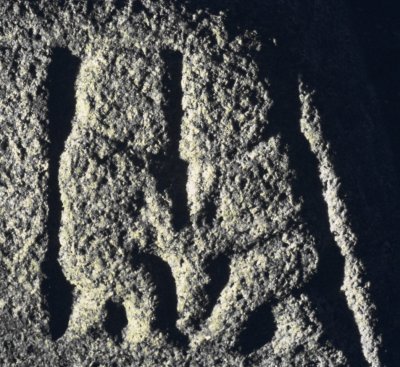
On
the Market Cross at Kells, the two figures are not kissing,
though they might be embracing (David and Absalom ?... SS
Paul the Hermit and Anthony ? ... Jesus and John the Baptist
?) Or are they wrestling (Jacob and the Angel) ?
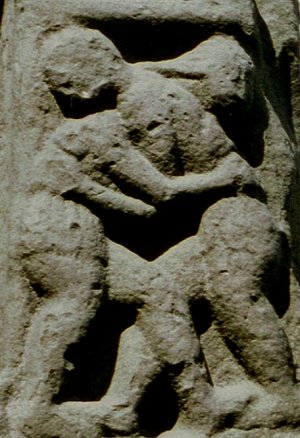
...while
at Lackagh in Tyrone is a fragment
with similar embracers - locally thought to be
a gravestone for
Siamese Twins.
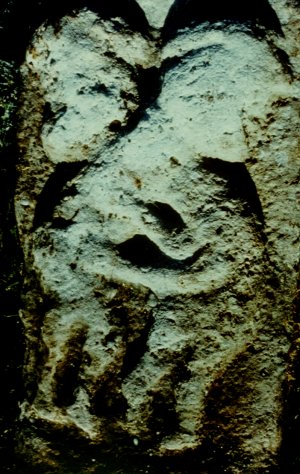
|
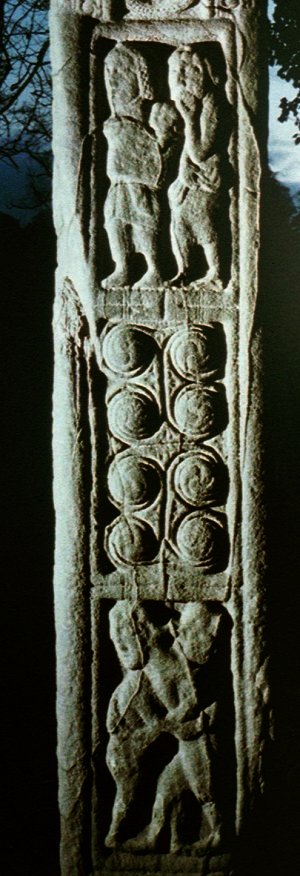
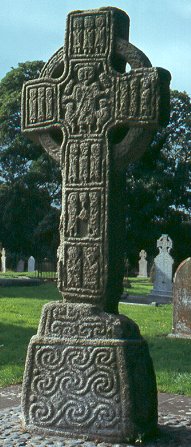
The
two figures also occur in purely Romanesque contexts,
as at Kilteel Church, county Kildare. 
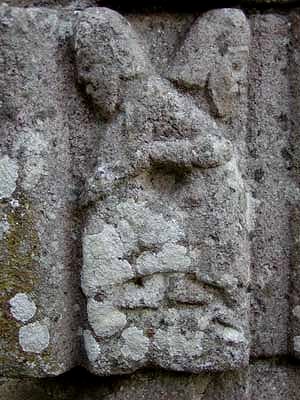
|
The very
worn cross at Downpatrick shows the usual Crucifixion on the E
face,
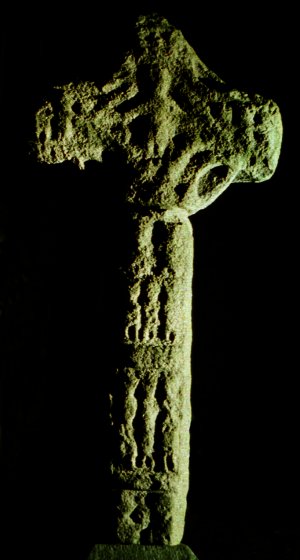
and below
it enigmatic groups of three which Peter Harbison suggests are
scenes from the early life of the Virgin, the bottom one being
an angel bringing bread to her in the Temple.
This cross has now been restored and placed within the
Down County Museum, close to the cathedral.
|
By
the time the last crosses in the series were erected, Ireland,
like Europe, had left the comparative innocence of the Romanesque
Era, with its emphasis on personal sin and redemption. In
Europe, the very success of the monastic orders, especially
the art-and-symbol-loving Benedictines, led to their decline
in favour of cities and their bishops. Catholicism and its
obsession with hierarchy, especially bishops, penetrated
Ireland, largely due to St Malachy, and, later, to the Norman
incursions from Wales which ended up as a hiccuping invasion
of the Eastern seaboard of Ireland. This was 'justified'
by the curious fact that Ireland was the only country in
the history of Christendom to have had no martyrs, no recorded
resistance to Christianity - but a plethora of dodgy saints
such as Declan who floated from Wales to south-eastern Ireland
on his tombstone, and Kevin who allowed a blackbird to build
a nest and hatch out chicks in his outstretched hand.
And
so the last 'High' Crosses of Ireland portrayed bishops
- here, at Kilfenora (right) smugly overseeing the
conquering of sin or heresy by two other ecclesiastics (with
Tau-cross and crozier) in a strange scene of vengeance which
still shows affinities with Pictish carvings, long after
Pictland ceased to exist politically.
On
the other side of this cross, Christ may be riding side-saddle
to interlacing, ribbony glory (depicted on the head) above
the rooves of Jerusalem, leaving Ireland (and Pictland)
far behind. 
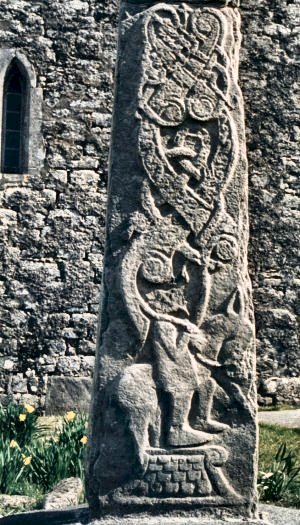
|
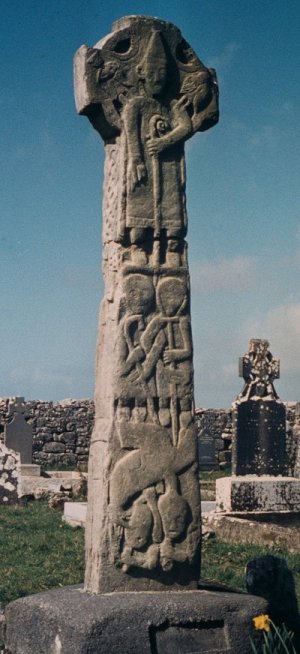
With
the coming of the English and the "High Middle Ages",
the graphic arts of Ireland, with their verve and quirkiness,
soon perished - never to be reborn. Erin, like other early-blossoming
Christian entities such as Georgia, entered its Dark Age,
from which it has even now only partly emerged.
Anthony
Weir

|
<<
Back to part One
|
 top of page
top of page 
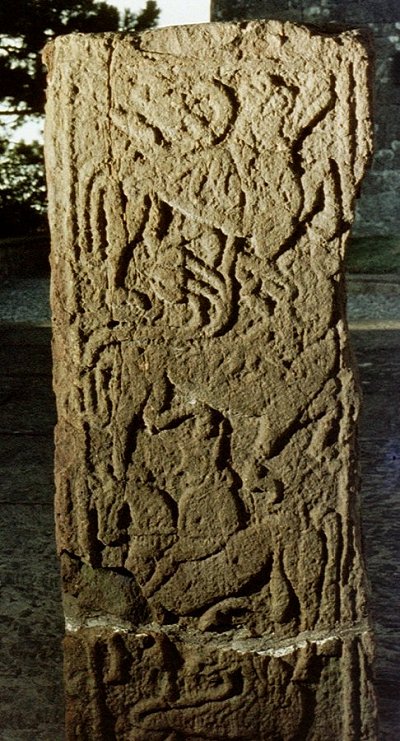
A wonderfully-composed hunting scene on a cross-shaft at Clonmacnois,
similar to some on Pictish slabs in Eastern Scotland.
This photo was taken in 1972: the carving has all but disappeared now,
and the same is true for all the unprotected crosses, cross-shafts, cross-pillars
and cross-slabs
that are part of the heritage that the Irish despise.
click to see a remarkable and almost-unknown cross-shaft
in Dublin city

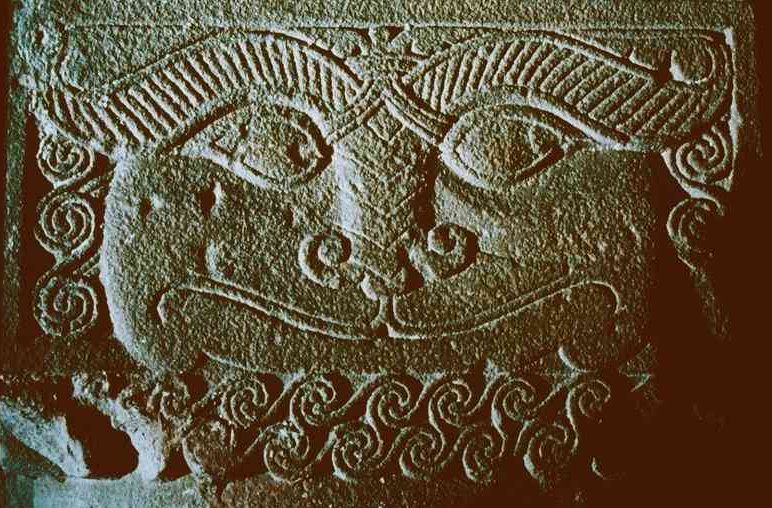
Is this Romanesque capital a depiction of beatitude
- or of beastliness ?
The doctrines of Judæo-Christianity (and Islam) make them into violent
opposites.

|


![]()
 Broken Cross, Kells
Broken Cross, Kells
![]()



